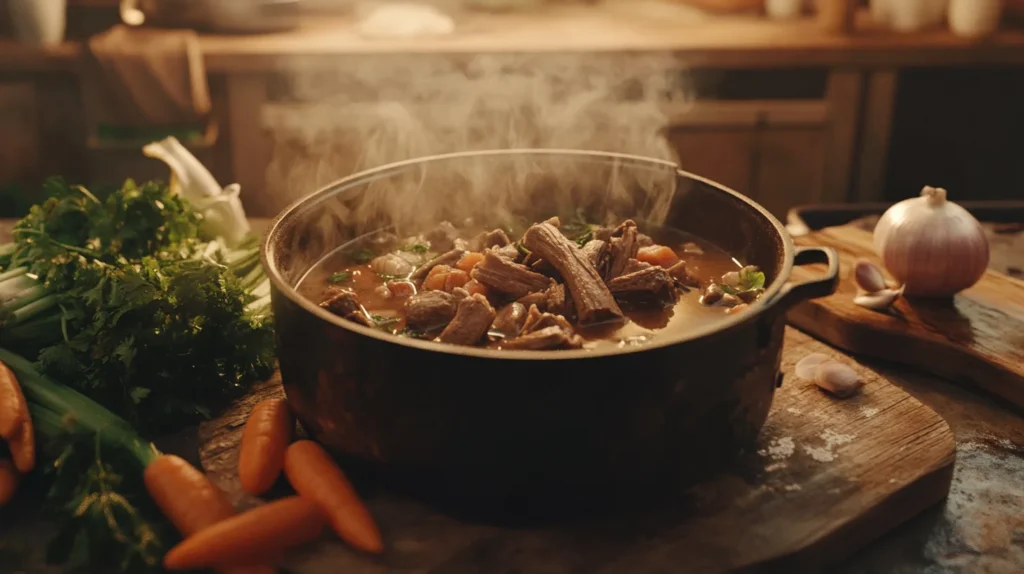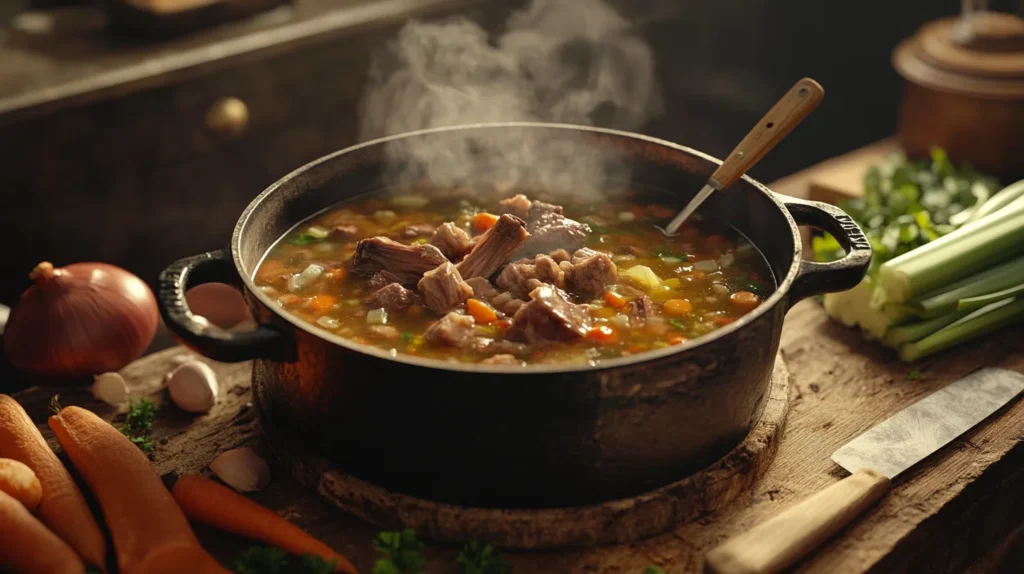Soup Bones: Your Ultimate Guide to Delicious and Hearty Broths
When it comes to creating rich, flavorful soups and broths, using quality soup bones can make all the difference. These bones, often simmered over long periods, release collagen and nutrients that give your dishes a deep, savory flavor while enriching their nutritional content. In this ultimate guide, we will delve into the art and science of using soup bones, exploring everything from selection to preparation, cooking techniques, and creative recipes that highlight these versatile ingredients. Whether you’re a seasoned chef or a home cook, you’ll discover insights and tips that will elevate your soup-making game.
The Art and Science of Soup Bones
Using soup bones in culinary practices is both an art and a science, balancing flavors, textures, and nutrient profiles to create comforting and delicious meals. Understanding how these bones work is essential for anyone interested in making rich stocks and hearty soups.
Definition and Types of Soup Bones
Soup bones refer to the bones used primarily in the preparation of soups and broths. They come from various animals, including beef, chicken, lamb, and pork, and can be categorized into several types based on their composition and intended use.
- Marrow Bones: These are large bones filled with nutrient-rich marrow. When cooked, marrow adds a luxurious texture and richness to broths. Marrow bones are typically used in French cuisine for traditional bone marrow soup.
- Joint Bones: These contain cartilage and connective tissues. When simmered, they break down into gelatin, resulting in a thick, luscious broth. Joint bones are excellent for hearty soups and stews.
- Knuckle Bones: Knuckles are particularly rich in collagen and ideal for making gelled broths. They’re commonly used in Italian recipes and Asian dishes like ramen.
The variety of soup bones you choose will influence the flavor and texture of your final dish, so understanding the differences is crucial.
Nutritional Benefits of Using Soup Bones
In addition to enhancing flavor, soup bones offer numerous nutritional benefits that should not be overlooked. These bones are often high in collagen, which is known to support joint health, skin elasticity, and digestive function.
Collagen-rich broth has been praised for its potential to improve gut health due to the presence of amino acids like glycine and proline, which play key roles in repairing the intestinal lining. Furthermore, the minerals extracted during the simmering process—such as calcium, magnesium, and phosphorus—are vital for bone health and overall well-being.
Moreover, soup bones are an economical way to utilize parts of the animal that might otherwise go to waste. By incorporating them into your diet, you are not only making a nourishing meal but also practicing sustainable cooking by minimizing waste.

Popular Varieties of Soup Bones Across Cultures
Different cultures around the world have their own unique approaches to using soup bones, showcasing regional ingredients and customs.
- Chinese Cuisine: Bone broth forms the base of many beloved dishes, such as hot pot and congee. It’s common to see beef, pork, or duck bones simmering with ginger, scallions, and spices for hours.
- French Cuisine: The classic French pot-au-feu utilizes beef bones, typically shank and oxtail, slow-cooked with vegetables to create a robust and hearty dish.
- Japanese Cuisine: Ramen broth is made by boiling pork bones (tonkotsu) for an extended period, producing a creamy, rich stock that encapsulates umami flavors.
By exploring these cultural distinctions, you can expand your culinary horizons and gain inspiration for new recipes involving soup bones.
How Soup Bones Contribute to Flavor and Texture
The allure of soup bones lies in their ability to enrich both the flavor and texture of your dishes. As the bones simmer, they release gelatin, fats, and proteins, transforming ordinary water into a velvety broth.
This transformation occurs through the process of extraction, where the heat breaks down the structures within the bones. The result is a nuanced flavor profile that enhances every ingredient in your soup, whether it’s herbs, vegetables, or meats.
The mouthfeel provided by bone broth is another significant advantage. A well-prepared broth has a silky, luscious texture that coats the palate, making each spoonful feel indulgent. This combination of flavor and texture elevates comfort food to new heights, making it a staple in many homes.
Selecting the Right Soup Bones
Choosing the right soup bones is paramount for achieving the desired flavor, nutrition, and culinary experience. Factors such as freshness, quality, and ethical sourcing all play a role in selecting the best bones for your kitchen.
Fresh vs. Frozen Soup Bones: What You Need to Know
When it comes to soup bones, you may encounter both fresh and frozen options at your local butcher or market. Each has its advantages, depending on your needs and preferences.
Fresh bones are often preferred if you plan to cook immediately. They tend to have a more robust flavor and are more likely to contain higher levels of moisture and gelatin. However, they may not always be available, especially if you’re looking for specific types of bones.
Frozen bones, on the other hand, can provide flexibility in timing. If you don’t have access to fresh bones, high-quality frozen options are excellent substitutes. Just ensure they’re properly stored and labeled, so you know what you’re working with.
Tips for Choosing Quality Bones
Selecting quality soup bones involves more than just picking up any package from the store. Here are some tips to ensure you make the best choice:
- Look for Marbling: Bones with visible marbling indicate higher fat content, which contributes to a richer broth. Look for cuts that have some meat attached, as this will enhance the depth of flavor.
- Check for Freshness: Always inspect the bones for signs of freshness. They should appear moist and have no off-putting odors. If purchasing from a butcher, don’t hesitate to ask questions about the sourcing and handling of the bones.
- Avoid Processed Options: Steer clear of processed or pre-packaged bones that may contain preservatives or additives. Opt for whole, natural bones whenever possible for the best results.
Sustainable Sourcing: Ethical Considerations in Bone Selection
As consumers become increasingly conscious of food sourcing, considering the ethics of your soup bones selection plays an important role. Sustainable sourcing practices involve choosing bones from animals raised humanely and fed a natural diet.
- Local Farms: Whenever possible, buy from local farms that prioritize animal welfare and sustainable practices. Not only will you support your community, but you’ll also enjoy fresher products.
- Grass-Fed vs. Grain-Fed: Grass-fed animals tend to produce tastier bones due to their natural diets. If you have the option, seek out bones from grass-fed sources for optimal flavor and nutritional value.
By being mindful of how and where you source your soup bones, you contribute to a more environmentally friendly food system while enjoying delicious soups.
Common Mistakes When Buying Soup Bones
When diving into the world of soup bones, there are several pitfalls to avoid to ensure you select the best ingredients for your culinary creations.
- Overlooking Quality: One of the most common mistakes is prioritizing price over quality. While budget considerations are important, sacrificing quality can lead to lackluster results. Invest in the best bones you can afford for superior flavor.
- Failure to Ask Questions: Don’t hesitate to engage with your butcher or market staff. Asking about the sourcing, processing, and recommended uses for specific bones can provide you with valuable insights and help you make informed choices.
- Ignoring Cuts and Types: Many cooks make the mistake of using the same type of bone for every recipe. Different cuts yield different flavors and textures, so explore a range of options to find the perfect match for your dish.
By avoiding these missteps, you’ll be better equipped to select excellent soup bones that enhance your culinary endeavors.

Preparing Soup Bones for Cooking
Once you’ve selected your soup bones, proper preparation is essential for extracting the maximum flavor and nutrients. The way you prepare your bones can significantly impact the quality of the broth you ultimately create.
Cleaning and Prepping Bones: Best Practices
Before you begin cooking, it’s imperative to clean and prep your bones. Proper cleaning ensures that any impurities are removed, allowing for a clearer broth.
Rinse your bones under cold running water to remove any surface debris. For added cleanliness, you may want to soak them in cold water for an hour, changing the water halfway to eliminate excess blood and impurities.
Additionally, trimming away excess fat can prevent your broth from becoming greasy. However, keep some fat intact, as it contributes to the richness of flavor.
Roasting Bones: Enhancing Flavor
Roasting soup bones before simmering is a technique frequently employed to enhance the flavor of your broth. This method caramelizes the natural sugars in the bones, creating a deeper, more complex taste.
To roast your bones, preheat your oven to a high temperature, around 400°F. Spread the bones out on a roasting pan, ensuring they are not overcrowded. Roast them for about 30 minutes, turning them halfway through to achieve an even golden-brown color.
The fragrant aroma that fills your kitchen as the bones roast is a delightful precursor to the rich broth that awaits. This step not only intensifies flavor but also adds beautiful color to your final product.
Soaking Bones: Is It Necessary?
Soaking soup bones has been a topic of debate among chefs and home cooks alike. Some argue it’s unnecessary, while others claim it aids in flavor extraction.
Soaking may help draw out some of the blood and impurities, leading to a cleaner-tasting broth. Soaking for a couple of hours before cooking can also hydrate the bones, allowing them to better absorb water during the simmering process.
Ultimately, whether to soak depends on your preference. Experiment with both methods to determine what works best for you.
The Importance of Blanching Bones
Blanching is a technique that involves briefly boiling the bones before simmering them for an extended period. This method serves to further cleanse the bones and enhance the clarity of your broth.
To blanch, place your bones in a pot of cold water and bring it to a boil. Allow them to boil for about 10 minutes before draining and rinsing them under cold water. This step removes excess blood and impurities, resulting in a clearer broth.
Blanching is particularly beneficial when using bones with a lot of connective tissue, as it helps eliminate unwanted flavors that can detract from the final product.
Cooking Techniques for Soup with Bones
With your soup bones prepped and ready, the next step is determining the best cooking technique to extract maximum flavor. There are various methods to consider, each offering unique benefits and results.
Traditional Methods: Stovetop vs. Slow Cooker
Two of the most popular traditional cooking methods for preparing broth are stovetop and slow cooker methods. Each has its pros and cons, so let’s explore both.
Stovetop cooking allows for greater control over the simmering process. You can adjust the heat as needed and test for flavor intensity regularly. This method is ideal for those who prefer a hands-on approach and want to infuse their broth with additional flavorings throughout the cooking process.
On the other hand, slow cooking offers convenience and ease. Simply add your soup bones and water to the slow cooker, along with aromatics and seasonings, and let it work its magic for several hours. This method is perfect for those who want to set it and forget it, returning later to a beautifully developed broth.
Instant Pot and Pressure Cooking Techniques
For those seeking speed without sacrificing flavor, the Instant Pot and pressure cooking methods present an excellent alternative. These modern appliances can drastically reduce cooking time while still producing rich and flavorful broths.
When using an Instant Pot, simply add your cleaned bones, water, and seasonings, then seal the lid and set it to high pressure. In a fraction of the time required for traditional methods, you can achieve a deeply flavored broth.
One thing to keep in mind is that the flavors may differ slightly from slow-simmered broths, as the pressure cooking process extracts flavors more quickly. However, it remains a fantastic option for busy cooks needing rapid results.
Making Broth vs. Stock: Understanding the Differences
It’s essential to differentiate between broth and stock when discussing cooking with soup bones. Though used interchangeably in casual conversation, they serve different purposes in cooking.
Broth is primarily made by simmering meat and bones together, often featuring additional vegetables and aromatics. It’s lighter in flavor and can be seasoned and enjoyed as a standalone dish.
Conversely, stock is made solely from bones—preferably ones rich in collagen—and tends to simmer longer than broth. Stock has a thicker consistency due to the gelatin released during cooking and is often used as a base for sauces and gravies.
Understanding these differences can help you decide how to use your soup bones effectively, depending on your culinary goals.
Infusing Flavors: Herbs, Spices, and Aromatics
Enhancing your broth’s flavor profile begins with the careful selection of herbs, spices, and aromatics. The right combination can take your broth from good to extraordinary.
Start with aromatic vegetables, such as onions, garlic, carrots, and celery, known as mirepoix. These ingredients provide a flavorful foundation for your broth.
Next, consider adding herbs like thyme, bay leaves, or parsley stems. Whole spices like peppercorns or cloves can add complexity without overwhelming the dish. Remember to remove any large pieces after cooking to maintain a smooth texture.
Experimenting with different flavor combinations is part of the joy of cooking. Take the opportunity to try new ingredients based on the cuisine or dish you’re aiming to create, and embrace the creativity that comes with crafting a homemade broth.

Creative Recipes Featuring Soup Bones
Armed with knowledge about soup bones and their preparation, it’s time to dive into some creative recipes that showcase their incredible flavor and versatility.
Classic Bone Broth Recipe
A classic bone broth recipe is a great starting point for anyone looking to master the art of utilizing soup bones. Here’s a basic outline to get you started:
- Begin by roasting marrow and joint bones in a preheated oven until browned.
- Transfer the roasted bones to a large pot or slow cooker, and cover them with water.
- Add in mirepoix vegetables, garlic, herbs, and optional spices like peppercorns.
- Bring the mixture to a boil, then reduce to a simmer. Cook for anywhere from 12 to 24 hours, depending on your desired richness.
- Once finished, strain the broth and discard solids. Allow it to cool, then store it in the refrigerator or freezer.
The result is a nutrient-rich, flavorful broth that can be enjoyed on its own or used as a base for other dishes.
Hearty Vegetable and Meat Soup
Transform leftover soup bones into a hearty vegetable and meat soup that warms the soul. Follow these steps for a satisfying meal:
- Use the leftover broth from your bone broth recipe as the base.
- Add diced vegetables, such as potatoes, carrots, and green beans, along with cooked meat from the bones (shredded).
- Season with herbs and spices, adjusting to taste.
- Let the soup simmer until the vegetables are tender, and flavors meld together.
This recipe is incredibly flexible; feel free to incorporate seasonal vegetables or utilize whatever you have on hand. The goal is to create a comforting, nourishing dish that showcases the wonderful flavors achieved from your soup bones.
International Soups: Pho, Ramen, and More
Explore international cuisines that highlight the versatility of soup bones. Both pho and ramen use bone broth as their foundation, each lending its unique twist on flavor.
For pho, start with a beef bone broth infused with star anise, cinnamon, ginger, and shallots. Serve with rice noodles, thinly sliced meat, bean sprouts, basil, and lime for an authentic Vietnamese dish.
For ramen, utilize pork bones to create tonkotsu broth, characterized by its creamy consistency. Combine with ramen noodles, soft-boiled eggs, nori, and green onions for a delicious Japanese meal.
These recipes celebrate the global influence of soup and demonstrate the adaptability of using soup bones in diverse ways.
Using Leftover Soup Bones in Other Dishes
Don’t let leftover soup bones go to waste! There are plenty of ways to repurpose them into new culinary creations.
- Casseroles: Shred any remaining meat from the bones and incorporate it into casseroles, adding flavor and protein to the dish.
- Sauces and Gravies: Use strained broth from your soup bones as the base for sauces, adding depth to your culinary repertoire.
- Rice Dishes: Cook grains such as rice or quinoa in your bone broth to infuse extra flavor into side dishes.
Being inventive with your leftovers allows you to maximize the potential of your soup bones, ensuring nothing goes unutilized.
Frequently Asked Questions (FAQs)
What are soup bones?
Soup bones are the bones of various animals, typically beef, chicken, pork, or fish, that are used to create flavorful broths and stocks. These bones are rich in collagen, marrow, and connective tissue, all of which break down when simmered over a long period, infusing the broth with rich flavors and essential nutrients. Soup bones can be purchased from butchers, farmers’ markets, or grocery stores, and they are a staple in many culinary traditions for making hearty soups, stews, and sauces.
What is a soup bone slang?
In slang, people sometimes use the term ‘soup bone’ to describe someone considered unimportant or expendable. This usage reflects how bones, after serving their main purpose in cooking, are often discarded. However, this slang is less common. More widely, the term refers to the bones used in cooking to make broths and stocks.
What is the best bone for soup?
The best bones for soup depend on the flavor profile you’re aiming for. Beef bones, such as marrow bones, knuckle bones, and oxtail, are ideal for rich, hearty broths. Chicken bones are lighter and perfect for quick broths, while pork bones provide a sweet, deep flavor, especially in Asian broths. Fish bones are best for seafood broths and offer a light, briny taste. Ultimately, the best bone depends on the dish you’re preparing, with each type offering its unique flavor and texture.
Are soup bones the same as bone marrow?
Soup bones and bone marrow are related but not the same. Soup bones refer to any bones used for making broths, while bone marrow specifically refers to the soft, fatty substance found inside the bones. Marrow bones, often used in making beef broth, are a type of soup bone that contains a high amount of marrow, which adds richness and flavor to the broth when simmered.
Can I eat the meat from soup bones?
Yes, you can eat the meat from soup bones. While the meat on soup bones is often tougher and leaner compared to cuts of meat intended for roasting or grilling, it can still be flavorful and nutritious. Once the bones have been simmered to create a broth, the meat can be shredded and added back into the soup, stew, or used for other dishes like tacos, sandwiches, or salads. For beef or pork bones, the meat will be tender but may require additional cooking time to become fully edible.
Are soup bones the same as oxtail?
Sue bones and oxtail are related but not the same. Oxtail specifically refers to the tail of the cow, which contains both bone and a significant amount of meat. Known for its rich flavor, oxtail is commonly used in soups and stews, particularly in Caribbean and African cuisines. While soup bones can come from any part of an animal, oxtail is a specific cut often considered a type of soup bone. This is due to its bone content and ability to create flavorful, gelatinous broths when simmered.
Conclusion
The journey into the world of soup bones is one filled with discovery and delight. From understanding different types of bones to mastering cooking techniques and exploring global recipes, the possibilities are endless. As you experiment with your creations, remember that the heart of every great soup begins with the quality of its ingredients—particularly the soup bones.
So whether you’re crafting a rich bone broth or whipping up a cozy vegetable soup, lean into the comforting flavors and health benefits that soup bones can provide. Embrace the art and science behind these culinary treasures and revel in the satisfaction of creating something truly special in your kitchen. Happy cooking!
Craving a comforting and hearty dish? Try Benigni’s Potato Soup Recipe for a bowl of creamy perfection. Click here to get the full recipe!
Print
Soup Bones: The Ultimate Guide
- Total Time: 4-12 hours 10 min
- Yield: 8–10 cups broth 1x
Description
Soup bones are the foundation of rich and hearty broths and soups, packed with natural flavor and nutrients. Whether you’re using beef, pork, chicken, or lamb bones, they add depth and body to your homemade soup. This guide will help you craft a flavorful stock and turn it into a delicious, satisfying soup.
Ingredients
For Bone Broth Base:
- 2–3 lbs of soup bones (beef, chicken, pork, or lamb)
- 1 onion, quartered
- 2 carrots, chopped
- 2 celery stalks, chopped
- 3 garlic cloves, crushed
- 2 bay leaves
- 1 teaspoon black peppercorns
- 1 tablespoon apple cider vinegar (helps extract minerals)
- 10 cups water
For Soup Variations:
- Vegetable Soup: Add diced potatoes, tomatoes, green beans, and corn.
- Beef Barley Soup: Add cooked barley, shredded beef from the bones, and fresh parsley.
- Chicken Noodle Soup: Use chicken bones, shredded chicken, and egg noodles.
Instructions
Step 1: Roast the Bones (Optional for Added Flavor)
- Preheat your oven to 400°F (200°C).
- Place the soup bones on a baking sheet and roast for 30 minutes, turning once.
Step 2: Make the Bone Broth
- In a large stockpot, combine the roasted bones, vegetables, bay leaves, and peppercorns.
- Add water and apple cider vinegar. Bring to a boil over medium heat.
- Reduce to a simmer and cook for:
- 4-6 hours for chicken bones
- 8-12 hours for beef or pork bones
- Skim off foam and fat periodically.
- Strain the broth through a fine mesh sieve into a clean pot or storage container.
Step 3: Prepare the Soup
- Use the strained broth as the base for your soup.
- Add vegetables, grains, or noodles, and simmer until cooked.
- Season with salt and pepper to taste.
Notes
- Store broth in the refrigerator for up to 5 days or freeze for up to 6 months.
- Use silicone ice cube trays to freeze small portions for easy use in recipes.
- Add a splash of soy sauce or miso for an umami boost in the broth.
- Prep Time: 10 minutes
- Cook Time: 4-12 hours
- Category: Soup, Broth
- Method: Stovetop
- Cuisine: Global
Nutrition
- Serving Size: 1 cup
- Calories: 30-50
- Sugar: 0g
- Sodium: 120-150mg
- Fat: 1-3g
- Saturated Fat: 1g
- Unsaturated Fat: 1g
- Trans Fat: 0g
- Carbohydrates: 0-2g
- Fiber: 0g
- Protein: 5-8g
- Cholesterol: 10mg
Keywords: Soup Bones, Bone Broth Recipe, Homemade Broth

